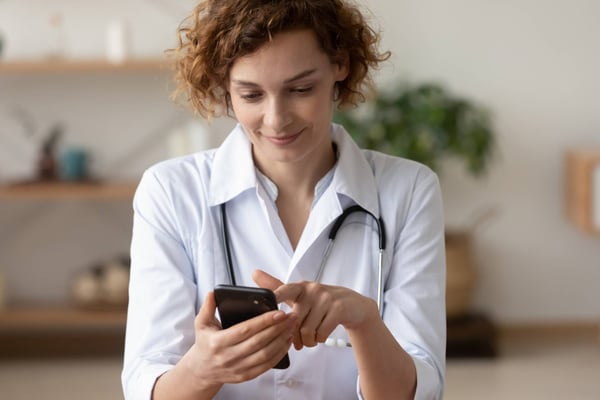We’ve spoken to Charlotte Lundholm, project manager and e-health strategist at Närhälsan, the primary healthcare provider in Västra Götaland County, who helped establish the first virtual youth clinic in Sweden in December 2016. How have things worked out and what have they learned along the way?
How does it feel to have been involved in starting the first virtual youth clinic in Sweden?
The virtual youth clinic is one of the most rewarding projects I’ve worked on. The whole idea of a new approach to dealing with young people on their own terms is great!
How did you get started?
We started planning in June 2016. At this point, a number of pilot projects for digital healthcare appointments were already underway in our GP practices, so it was a good time to start thinking about how we could facilitate this channel of contact for our young people. We created a form for school pupils in which we asked if they would like to visit a virtual clinic and what opening hours they would prefer. We quickly understood that there was a need for this service.
What were the major driving forces?
Video meetings enable us to reach out to more young people, especially those who don’t drive or who live far from the physical practices. There are also young people who, for various reasons, don’t want to attend a GP practice in person. This service considerably lowers the threshold for making contact.
Another driving force to get the project off the ground was the ambition to increase accessibility without the need to recruit more staff. Midwives are scarce, and through digital care consultations, staff can cooperate, whatever local practice they are associated with.
“Give it a try – and iron things out as you go along.”
-Charlotte Lundholm
What does a consultation involve?
We work on a drop-in basis with our virtual youth clinic, where the patients initiate contact. The patients download our app, register their details and then go to our drop-in clinic. They log in using BankID and describe their issue briefly so that the video call is assigned to the right healthcare worker. They are then placed in an e-waiting room until our staff contacts them by video call. The process is simple and efficient, and apps are an obvious choice of tool today for young people in many contexts.
Who is staffing the clinic?
The clinic is currently staffed by midwives, counsellors, psychiatric nurses, and psychologists, who handle different types of cases.
What do the staff think about this new way of working?
The staff had quite a few apprehensions before we got going. Among other things, they were afraid the technology would be difficult to handle (‘we’re healthcare workers, not technicians’) or that they wouldn’t have time to answer all of the calls. But once we’d started and were able to evaluate, we were able to laugh at many of our previous concerns; they’ve proven to be totally unnecessary. The technology is intuitive and simple to use. As one of our midwives said: ‘It’s easy peasy!’.
By using double screens with patient records on one and the video call on the other, the personnel can avoid having to switch between different windows.
Have you received any feedback from your younger users?
Our young people have really taken to the idea of being able to contact us via the virtual youth clinic. They find it easy and comfortable to ask questions about contraceptives, etc., without having to travel long distances. We have even had video meetings with young Swedish people abroad, in Gran Canaria and Cuba! They have been overjoyed at the opportunity to handle their visit from any location.
Our young users have also provided highly favourable ratings in the evaluation section of our app. For the question ‘Would you recommend a video consultation to someone you know?’, the result is a perfect 4/4 – you can’t get better than that!
What are the biggest advantages of virtual healthcare?
There are many advantages, but the biggest are physical independence and flexibility. It’s extremely beneficial for patients and personnel alike. Another advantage is that the visual contact in combination with young people having to identify themselves via BankID means a higher quality of service when compared with a normal phone conversation. Reduced environmental impact, due to reduction in travel, is another gain.
Do you have any tips on what others should think about if they want to start up a virtual clinic?
Give it a try – and iron things out as you go along. You can’t expect everything to be perfect from day one; we’ve had to continuously adjust the times, personnel and procedures for our video meetings.
Video meetings suit some target groups but not others. Think about which patients within your operations would benefit from this solution and organise the staffing accordingly, with appropriate professions. Remember that it can take time to get patients to change their channel of communication, and don’t give up!
To start with, it might be a good idea for health care professionals to allocate time to use for video consultations, such as Tuesdays at 12 – 15, so that it becomes part of everyday life.
Leadership is also important, as well as the realisation that major changes to work processes require a change process in each individual. It is important to remain humble about the fact that personnel may have a sense of insecurity as they have never previously carried out their work in this manner.
How does the future look?
The more comfortable we become with the service, the more areas we want to work with. We can see many opportunities! The goal is for all of Närhälsan’s 46 physical practices to jointly staff the virtual youth clinic in 2018.
Anything else you would like to add?
I want to take the opportunity to pay tribute to our midwives, as well as other personnel at our youth clinics who are doing an amazing job with the new approach. Their attentiveness and commitment have been invaluable to our operations!


